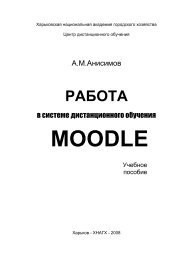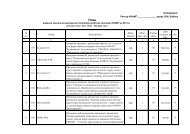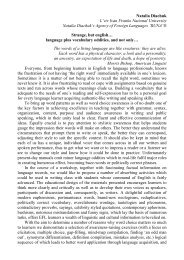The Reading Comprehension Section You will read this text and you ...
The Reading Comprehension Section You will read this text and you ...
The Reading Comprehension Section You will read this text and you ...
You also want an ePaper? Increase the reach of your titles
YUMPU automatically turns print PDFs into web optimized ePapers that Google loves.
Part A<br />
<strong>The</strong> <strong>Reading</strong> <strong>Comprehension</strong> <strong>Section</strong><br />
<strong>You</strong> <strong>will</strong> <strong>read</strong> <strong>this</strong> <strong>text</strong> <strong>and</strong> <strong>you</strong> are to choose the one best answer A, B,<br />
C, or D to each question.<br />
TEXT 1<br />
Read <strong>and</strong> translate the <strong>text</strong> using a dictionary<br />
Keywords: Mars, canal, outer, astronomer, theory, soil, experiment, man-made,<br />
life, storm, water, quantity, spacecraft, volcano, mile, diameter, circle, planet<br />
Of the six outer planets, Mars, commonly called the Red Planet, is the closest to<br />
Earth. Mars, 4,200 miles in diameter <strong>and</strong> 55% of the size of Earth, is 34,600,000<br />
miles from Earth, <strong>and</strong> 141,000,000 miles from the Sun. It takes <strong>this</strong> planet, along with<br />
its two moons, Phobos <strong>and</strong> Deimos, 1.88 years to circle the Sun, compared to 365<br />
days for the Earth.<br />
For many years, Mars had been thought of as the planet with the man-made canals,<br />
supposedly discovered by an Italian astronomer, Schiaparelli, in 1877. With the<br />
United States spacecraft Viking I’s l<strong>and</strong>ing on Mars in 1976, the man-made canal<br />
theory was proven to be only a myth.<br />
Viking I, after l<strong>and</strong>ing on the soil of Mars, performed many scientific experiments<br />
<strong>and</strong> took numerous pictures. <strong>The</strong> pictures showed that the red colour of the planet is<br />
due to the reddish, rocky Martian soil. No biological life was found, though it had<br />
been speculated by many scientists. <strong>The</strong> Viking also monitored many weather<br />
changes including violent dust storms. Some water vapour, polar ice <strong>and</strong> permafrost<br />
(frost below the surface) were found, indicating that at one time there were<br />
significant quantities of water on <strong>this</strong> distant planet. Evidence collected by the<br />
spacecraft shows some present volcanic action, though the volcanoes are believed to<br />
be dormant, if not extinct.<br />
1. Which of the following is not true?<br />
- 4 -

















